Norway
Grades 7+
The sun peeks over the horizon, casting a pink and orange glow across the sea. The Vikings have sailed for days. In the distance, a monastery perches atop a small island.
As the Vikings draw closer, they see monks scurrying, trying to prepare for the attack.
Too late. Swords drawn, the Vikings soon are upon them. The monks do not have a chance. The monastery is in flames. The Vikings loot and pillage everything they can find. Not only do they beat monks to death, drown them, and haul them away as slaves, they damage and desecrate the monastery’s holy relics.
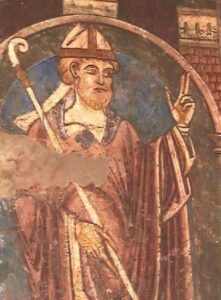 The year is 793. The monastery in question is St. Cuthbert in Lindisfarne (England), also called the Holy Island.
The year is 793. The monastery in question is St. Cuthbert in Lindisfarne (England), also called the Holy Island.
This is the first major Viking raid in history … a bloody and brutal start to the Viking era, one that would be remembered for centuries.
♦
Originating from Scandinavia, the Vikings were traders and farmers who doubled as pirates. They engaged in expeditions and raids all over Europe. They intended to trade and settle in new territories but soon took to plundering and bringing goods back to Norway.
♦
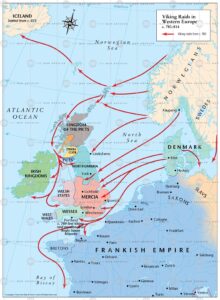 The Viking fleet grew until hundreds of ships, called langskip (longships), set sail throughout the Baltic Sea. They sailed up the Mediterranean and past Byzantium and into the Black Sea and the Caspian. They sailed up the great Russian rivers. They created colonies in Iceland and Greenland and what is now Canada.
The Viking fleet grew until hundreds of ships, called langskip (longships), set sail throughout the Baltic Sea. They sailed up the Mediterranean and past Byzantium and into the Black Sea and the Caspian. They sailed up the great Russian rivers. They created colonies in Iceland and Greenland and what is now Canada.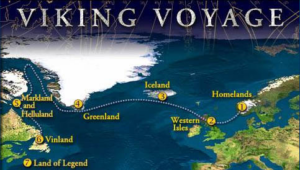
With favorable conditions, Viking ships could reach a speed of 15-17 knots (about 20 miles per hour). Such speed was an essential asset, for it allowed the Vikings to carry out sudden and surprising maneuvers.
♦
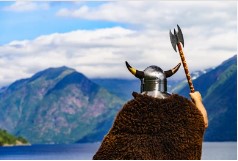
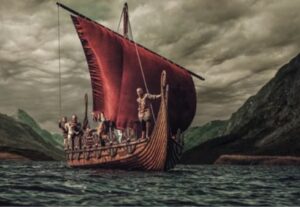 But the Vikings were not the only people to play an enormous role in Norway’s culture and history. There are also the Sámi.
But the Vikings were not the only people to play an enormous role in Norway’s culture and history. There are also the Sámi.
About 80,000 Sámi live in Norway, Sweden, Finland, and Russia. The vast majority of live in Northern Norway. Choosing a traditional nomadic life over a modern settled one, they rely on reindeer, which they herd, for meat, travel, and much of their clothing. They live in warm tents, where they dine on bidos (reindeer stew) and lefse (potato pancake). The seasonality of their life is built around the great annual reindeer migration, which occurs in April and May.
♦



The history of Norway is largely linked to that of the rest of Scandinavia, but its location to the west gives it a long coastline overlooking the Atlantic Ocean. The Norwegian coast is cut by many fjords, out of which the Vikings began their raids. Today, those fjords serve as homes to Norway’s fishing fleet and the destinations of tourists. Two fjords, Geirangerfjord and Sognefjord, are world heritage sites.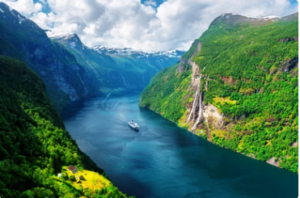
Spectacular mountains, some snow-peaked much of the year, jut up from the fjords. Combine high altitudes and snow and you get skiing. The Norwegians can be considered the inventors of modern skiing. The wood-processing industry was born from the demand of English merchants. In 1886, the first ski manufacturing factory opened in Oslo.
Norwegians love to ski, snowboard, and ice skate. The rugged landscape gives ample opportunity to stay active and fit. As a result, most Norwegians are athletic. Despite having a population of only 5.2 million, they have dominated such “giants” as Russia, Germany, and the United States. Norwegians have won 330 medals – the most of any nation – since the Winter Olympics began in 1924.
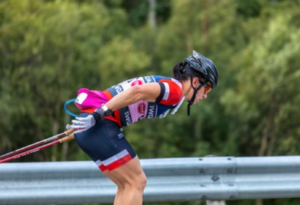 In 2018, they won a staggering 39 medals, including 16 golds, the most by any nation in a single Winter Games. They broke the record of 15 golds – a record they also held. The most medals by one person in the Winters Olympics is Norway’s cross-country skier, Marit Bjørgen, with 15. Close behind him is Bjorn Daehlie, with eight golds and four silvers.
In 2018, they won a staggering 39 medals, including 16 golds, the most by any nation in a single Winter Games. They broke the record of 15 golds – a record they also held. The most medals by one person in the Winters Olympics is Norway’s cross-country skier, Marit Bjørgen, with 15. Close behind him is Bjorn Daehlie, with eight golds and four silvers.
♦
 Nor is Norway’s success in sports only in the Winter Games.
Nor is Norway’s success in sports only in the Winter Games.
In the 2021 Games, held in China, Karsten Warholm broke the 29-year-old world record in the 400-meter hurdles. He ran the hurdles faster than 18 top athletes who ran a 400-meter race without hurdles!
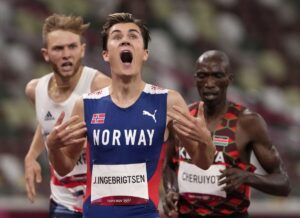 At just 16 years old, Norway’s Jakob Ingebrigtsen ran a mile in 3 minutes, 46.46 seconds. He became the youngest person ever to run the mile in under four minutes. Then, in the 2021 Summer Games, he became the third of three brothers to compete in an Olympics. He defeated the defending 1500-meter world champion and won the gold.
At just 16 years old, Norway’s Jakob Ingebrigtsen ran a mile in 3 minutes, 46.46 seconds. He became the youngest person ever to run the mile in under four minutes. Then, in the 2021 Summer Games, he became the third of three brothers to compete in an Olympics. He defeated the defending 1500-meter world champion and won the gold.
But perhaps his most remarkable achievement occurred when he didn’t win. He placed second in a race in California’s San Juan Capistrano – he was barely beaten by the former world champion. Jakob wondered why he had felt so physically weak during the event. The next day, he discovered that he had Covid! Ever confident, Jakob said, “I think if I was healthy, I would have won by 100 meters.”
♦
Such successes beg the question: Why do Norwegians do so well on the world’s athletic stage? Sports scientists have asked the same question. Some of their answers include:
- The high level of athleticism of the Norwegian people
- The excellent facilities and training opportunities
- The support of the government and population for Olympic athletes.
Another reason: the country’s strong focus on winter sports. But why would that help produce such phenomenal runners?
It seems that, because skiing uses poles and requires the use of all four limbs, people who engage in cross-country skiing have higher oxygen uptake than in running. That means even the most fit runner increases aerobic capacity by engaging in considerable cross-country skiing. 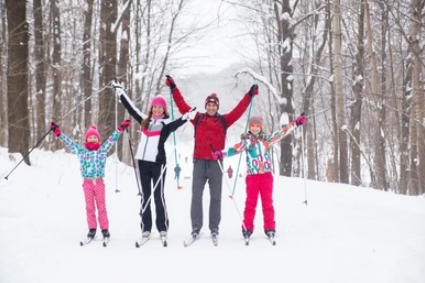
♦
The way Norwegians face life is also key to athletic success. Norwegians have developed a unique culture and lifestyle that has been shaped by their natural environment. Over the centuries, they have adapted to the harsh conditions of the Arctic by developing a strong sense of self-reliance and resourcefulness.
 They have also developed a deep respect for nature and the environment. This has led them to adopt a sustainable approach to life, which is reflected in their traditional way of living. Whether skiing, running, hiking, or taking a nap in a hammock, they love spending time outdoors, a concept they call friluftslivis, in the arms of Mother Nature. She rewards them with superior athletic skills.
They have also developed a deep respect for nature and the environment. This has led them to adopt a sustainable approach to life, which is reflected in their traditional way of living. Whether skiing, running, hiking, or taking a nap in a hammock, they love spending time outdoors, a concept they call friluftslivis, in the arms of Mother Nature. She rewards them with superior athletic skills.
Norway Activity 1
Name the parts of speech for the following sentences. Then draw and label trees.
Reindeer migrations control Sámi life.
Norwegians dominate winter Olympics.
Norway Activity 2
Teach an older person who is not in your class how to determine the parts of speech for the sentences below. Then show how to draw syntax tree(s). Explain the trees as together you draw and label the trees. They might think some words are adjectives. They’re not.
Sámi diners eat potato pancakes.
Karsten Warholm broke world hurdles records. (Treat Karsten Warholm as one word.)
Optional Activity
Want a chance to have your writing published on this website – and possibly win $500?
Then choose a subject from this list. Write an essay of 200-500 words. Follow the directions exactly. It is best if you do this activity as a class.
All students submitting an essay will receive a Certificate of Completion from Dr. George Guthridge.
Teachers and Parents:
Want a chance to have your students’ writing published on this website – and possibly win an additional $500 for your classroom?
Have your students choose a subject from this list. Write an essay of 200-500 words. Follow the directions exactly. It is best if you do this activity as a class. Then, as teacher, add an exercise. Make sure you approach nouns as this website does and not as traditional grammar does.
You can make an exercise like the one here, or you can develop an exercise of your own. The more creative and effective your exercise is, the better your chance to win the prize.
Note to teachers and parents: You do not have to engage in this part of the process for students to submit essays.